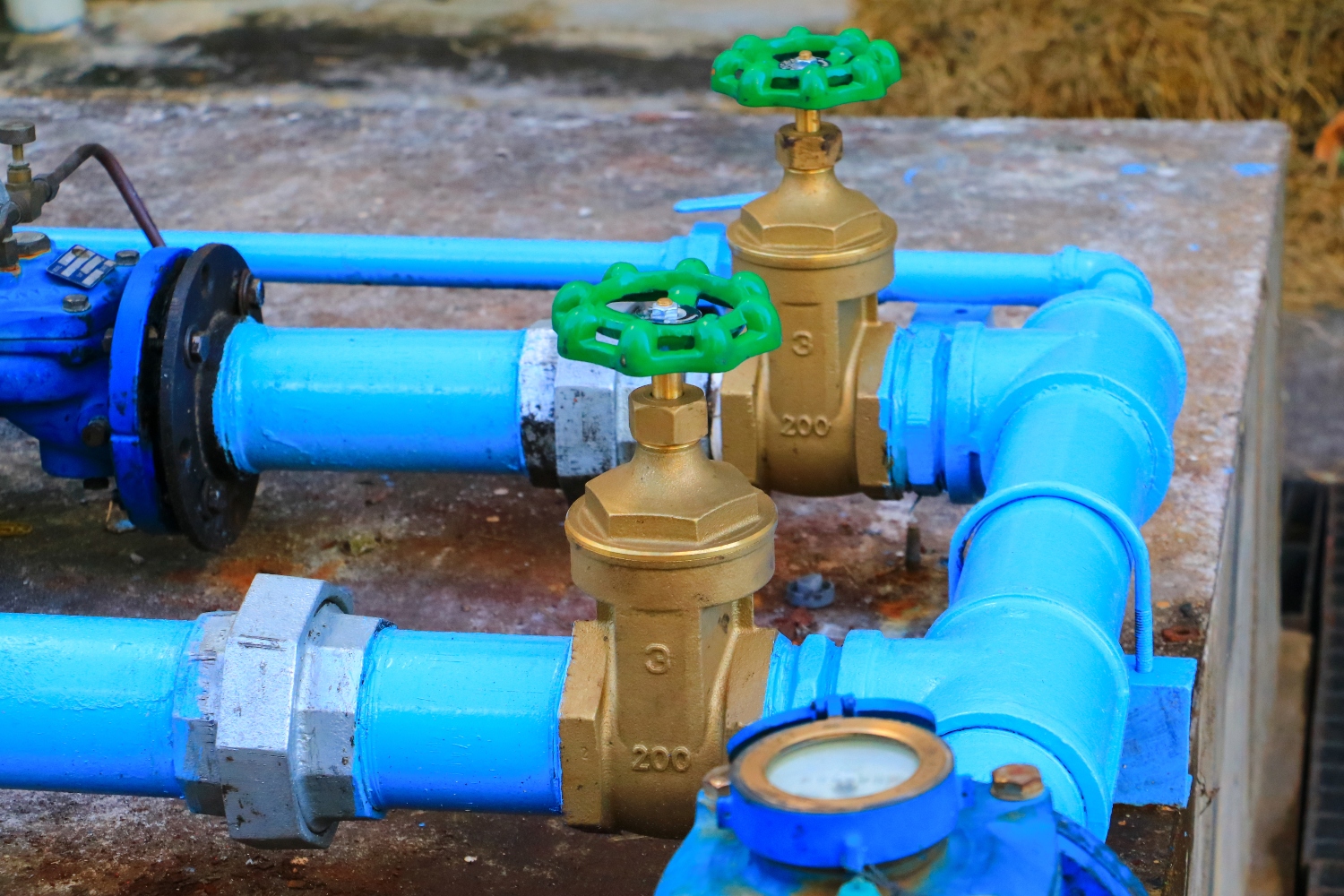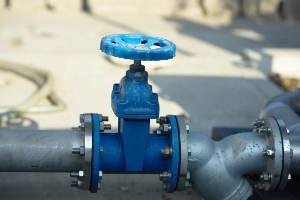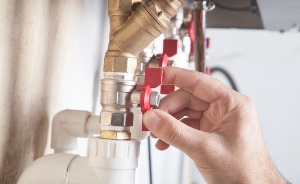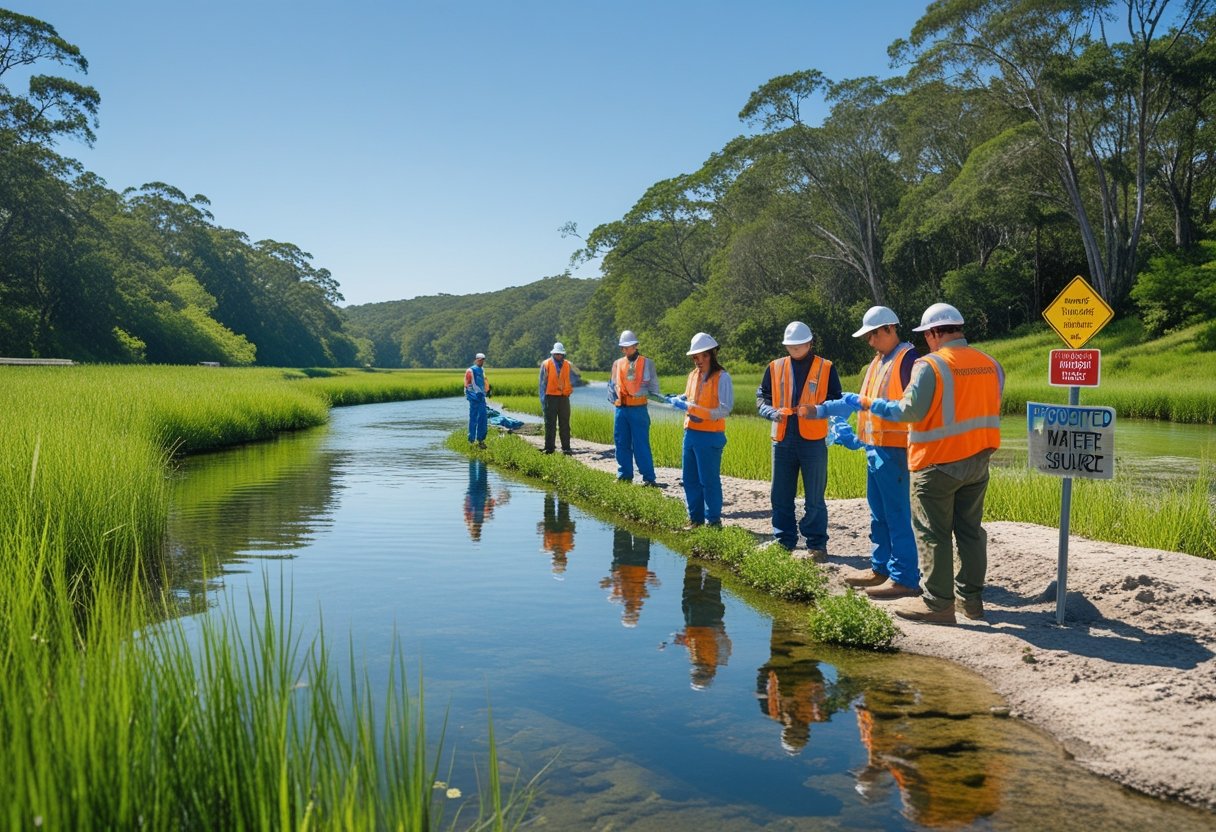Clean, safe water is essential for our homes and businesses, and every property owner should know how to prevent water contamination. Yet many people don't realize that their water supply faces a hidden danger called backflow. This occurs when contaminated water flows backward into clean water pipes, potentially introducing harmful substances like bacteria, chemicals, and pesticides into the water we use daily.
Backflow prevention devices are the most effective way to protect your water supply from contamination. These specialized valves work by allowing water to flow in only one direction, preventing the reversed flow that can bring contaminants into your clean water.
Without proper backflow prevention, you risk exposure to serious health hazards that could affect everyone who uses your water. We've seen the consequences of backflow incidents throughout history, including a tragic event at the 1933 Chicago World's Fair where contaminated water led to numerous illnesses and deaths.
Today, backflow prevention isn't just a good idea—it's legally required in all states, though specific regulations vary by location.
In this article, you’ll learn how to prevent water contamination in your home or business through effective backflow protection.
Here’s what you need to know:
- What causes water contamination in private plumbing systems
- How backflow prevention protects your drinking water
- Risks of not having a working backflow preventer
- Legal and financial consequences of water contamination
- How to stay protected and compliant
Keep reading! Understanding this risk and taking proactive steps can help ensure your water remains safe for all uses.
What causes water contamination in private plumbing systems
Private plumbing systems face several risks that can lead to water contamination. These issues often go unnoticed until they cause serious problems with water quality or safety.
Cross-connections between clean and contaminated water
Cross-connections occur when clean water pipes connect with pipes containing non-potable water. This creates a direct pathway for contaminants to enter your drinking water. Common cross-connections include:
- Garden hoses left in puddles, pools, or chemical solutions
- Irrigation systems connected directly to potable water lines
- Utility sinks with submerged hoses
- Boilers or water heaters without proper protection
We often see these issues in older homes where plumbing modifications happened without proper safeguards. Even temporary connections, like attaching a garden hose to apply fertilizer, can create dangerous cross-connections if water pressure changes unexpectedly.
Businesses face additional risks with equipment like commercial dishwashers, cooling systems, and medical equipment that may create cross-connections without proper separation between systems.
Back-siphonage and back-pressure events
Back-siphonage happens when negative pressure in water lines pulls contaminants into clean water pipes. This commonly occurs during:
- Water main breaks
- High water usage from firefighting
- Sudden changes in municipal water supply pressure
Back-pressure is different—it happens when pressure in a non-potable system exceeds the pressure in your drinking water lines. This can force contaminated water backward into clean water pipes.
Both events can introduce harmful substances like chemicals, bacteria, or waste into your drinking water without any visible signs. These pressure events are unpredictable and can happen suddenly, making prevention essential rather than reaction.
Aging infrastructure and improper irrigation setups
Deteriorating pipes, fixtures, and plumbing components significantly increase contamination risks. Corrosion in older pipes can introduce:
- Lead and copper into drinking water
- Rust particles that discolor water
- Tiny cracks where contaminants enter during pressure changes
Improper irrigation setups are another major concern. Many systems lack proper backflow prevention, especially older installations. Sprinkler heads that sit in puddles after rain can create direct pathways for fertilizers, pesticides, and animal waste to enter water lines during pressure fluctuations.
We regularly find irrigation zones connected directly to potable water without adequate backflow preventers. This creates a serious contamination risk whenever pressure changes occur in either system.
How backflow prevention protects your drinking water
Backflow prevention is essential for maintaining clean drinking water in our homes and businesses. These devices act as a barrier between our potable water and potential contaminants that could reverse flow into our clean water supply.
What is backflow and why it happens
Backflow occurs when water flows in the opposite direction than intended in your plumbing system. This happens through two main mechanisms: backpressure and backsiphonage.
Backpressure happens when pressure in your plumbing exceeds the pressure in the main water supply. This can be caused by:
- Malfunctioning water pumps
- Heating systems
- Elevated piping
Backsiphonage occurs when there's a significant drop in water pressure in the main line. This creates a vacuum effect that can pull water backwards. Common causes include:
- Water main breaks
- Fire hydrant use
- High water demand during emergencies
Cross-connections (points where drinking water connects with non-potable water) become dangerous during backflow events. Without protection, contaminants from garden hoses, irrigation systems, or industrial equipment can enter your drinking water.
According to EPA’s Cross‑Connection Control Manual, water providers must ensure that backflow prevention assemblies are tested regularly and maintained in proportion to the degree of hazard—failure to do so may result in water service being disconnected
Devices Like RPZs, DCVs, and PVBs: How They Work
Different backflow prevention devices serve specific purposes based on the contamination risk.
Reduced Pressure Zone (RPZ) devices:
- Contain two independent check valves with a pressure-monitored chamber between them
- Automatically discharge water if pressure drops
- Provide the highest level of protection
- Ideal for high-hazard situations like chemical processing facilities
Double Check Valve (DCV) assemblies:
- Feature two spring-loaded check valves in sequence
- Stop backflow by closing when water attempts to flow backward
- Best for moderate hazard situations
- Commonly used in fire sprinkler systems
Pressure Vacuum Breakers (PVB):
- Include an air inlet valve that opens when pressure drops
- Must be installed above all downstream piping
- Typically used for irrigation systems
- Less expensive but offer more limited protection
Why homes and businesses in California are required to test them
California takes water protection seriously through strict regulations and testing requirements. The California Water Code mandates backflow prevention for properties with potential cross-connections.
Annual testing is required for all backflow prevention devices in California. This ensures they function properly when needed most. Failed tests require immediate repairs and re-testing.
Different properties face different requirements:
- Businesses with chemical processes need RPZs
- Homes with irrigation systems typically need DCVs or PVBs
- Medical facilities have the strictest requirements
Only certified backflow testers can perform these inspections. Testing costs typically range from $75-150 annually. While this may seem like an expense, it's minimal compared to the potential health costs of contaminated water.
Local water suppliers maintain records of all testing and can shut off service to non-compliant properties. We recommend scheduling your annual test before your due date to avoid potential water shutoffs.
Risks of not having a working backflow preventer
Without a functioning backflow preventer, your water supply faces serious contamination risks that can affect health, property, and finances. These devices serve as critical barriers against pollutants entering your clean water system.
Irrigation chemical backflow
Lawn and garden irrigation systems often contain fertilizers, pesticides, and herbicides that can flow back into your drinking water when pressure changes occur. These chemicals contain toxic compounds that aren't meant for human consumption and can cause severe illness if ingested.
When water pressure drops in the main line, irrigation water can reverse direction and pull these harmful substances into your clean water supply. Even small amounts of these chemicals can cause nausea, dizziness, and long-term health problems.
Modern irrigation systems should include specialized backflow preventers designed for outdoor use. These devices must be tested annually, as exposure to weather conditions can cause them to fail over time.
We recommend installing reduced pressure zone (RPZ) backflow preventers for irrigation systems. These provide the highest level of protection against chemical backflow and are often required by local building codes.
Cross-contamination from commercial kitchens or laundries
Commercial kitchens and laundry facilities use chemicals and produce wastewater that pose significant health risks if they enter the potable water supply. Detergents, sanitizers, and food waste contain bacteria and harmful substances that shouldn't mix with drinking water.
In kitchens, dishwashers and pre-rinse sprayers can create backflow conditions when connected directly to water lines without proper protection. Grease traps and disposal systems can also become sources of contamination.
Laundry facilities use bleach, fabric softeners, and industrial cleaning agents that can cause serious health problems if they flow back into drinking water. These chemicals can also damage plumbing fixtures and appliances throughout a building.
We've seen cases where entire buildings required evacuation due to chemical odors from backflow incidents. Installing air gaps or mechanical backflow preventers on all commercial kitchen and laundry equipment is essential for safety.
Sudden drops in water pressure from hydrant use
When firefighters use hydrants during emergencies, they create sudden pressure drops in nearby water lines. These pressure changes can cause a reversal of water flow throughout the neighborhood's plumbing systems.
During these events, contaminants from pools, garden hoses, and other sources can be drawn into homes and businesses without backflow protection. Even street water containing motor oil, antifreeze, and road salt can enter the water supply.
Common signs of hydrant-related backflow include:
- Discolored water
- Unusual taste or odor
- Sediment in faucet aerators
- Reduced water pressure
Fire departments routinely test hydrants, creating similar pressure fluctuations. Without proper backflow prevention, these tests can introduce contaminants into your water supply without your knowledge.
Leaks from faulty boilers or heating systems
Boilers and heating systems contain chemicals like glycol, rust inhibitors, and treatment chemicals that prevent freezing and corrosion. These substances are highly toxic if they enter your drinking water supply.
A failing check valve or pressure loss can allow these chemicals to flow backward into your potable water. Older heating systems are particularly vulnerable to this type of cross-connection failure.
Warning signs of boiler backflow include:
Warning Sign
What It Means
Green or blue-tinted water
Antifreeze contamination
Metallic taste
Corrosion inhibitor present
Foaming water
Chemical additives in water
Unusual odor
Boiler treatment chemicals
We advise installing specialized backflow preventers on all boiler and heating system connections. These should be tested annually, especially before the heating season begins.
Legal and financial consequences of water contamination
Failing to prevent water contamination can lead to serious legal troubles and financial burdens. Property owners face potential lawsuits, regulatory penalties, and costly remediation requirements when contamination occurs.
Property liability and local code violations
When water contamination happens on your property, you may be legally responsible for all resulting damages. This includes harm to neighboring properties and any health issues affecting others. In California, regulations are particularly strict, with fines reaching thousands of dollars for code violations.
Local building codes typically require proper backflow prevention devices. Failure to install and maintain these can result in citations, penalties, and even property liens.
We've seen cases where businesses faced lawsuits exceeding $100,000 after contamination events that could have been prevented with proper backflow devices. Insurance policies often exclude coverage for preventable contamination issues, leaving you to bear the full financial burden.
Regular inspections by certified professionals help ensure compliance with regulations. This small investment protects you from much larger financial consequences down the road.
How to stay protected and compliant
Maintaining compliance with backflow prevention regulations requires regular attention and professional oversight. Proper maintenance not only keeps your water supply safe but also helps you avoid potential fines and legal issues.
Annual testing and certified inspections
Annual testing of backflow prevention devices is mandatory in California. We recommend scheduling these inspections well before your due date to avoid last-minute compliance issues.
Only certified backflow testers should perform these inspections. These professionals have completed specific training and certification programs required by the state of California to properly evaluate your devices.
During the inspection, the tester will check all components of your backflow preventers, including valves, relief ports, and pressure differentials. They'll verify that the device operates correctly under various conditions.
Keep a record of all inspection dates and results. This documentation proves your commitment to compliance and provides a history of your system's performance over time.
The DOE’s Federal Energy Management Program notes that backflow preventers in rainwater harvesting systems must be tested annually, or as required by local regulation, to prevent reverse flow into potable water systems
Repair and replacement of failed or outdated devices
When a backflow device fails testing, immediate repair or replacement is necessary. Continuing to operate with a faulty device puts your water supply at risk and violates regulations.
Common issues requiring repair include:
- Leaking valves
- Stuck check valves
- Damaged relief valves
- Pressure problems
We recommend working with licensed plumbers who specialize in backflow systems for repairs. They understand the complex requirements and can ensure proper functioning.
Most backflow preventers have a lifespan of 5-10 years, depending on water quality and usage patterns. Planning for periodic replacement helps avoid unexpected failures and compliance issues.
Full reporting to California water authorities
After testing is complete, results must be submitted to your local water authority within 30 days. This reporting requirement applies regardless of whether your device passed or failed.
The standard California backflow testing form requires:
- Property information
- Device specifications
- Test results with exact measurements
- Certified tester information and signature
Many jurisdictions now offer online reporting systems that streamline this process. We recommend confirming your local authority's preferred submission method before your inspection.
Failure to report can result in fines starting at $500, with additional penalties for continued non-compliance. Some districts may also shut off water service until compliance is verified.
Conclusion
Protecting your water supply from contamination is not just important—it's essential for health and safety. Backflow prevention devices serve as the first line of defense against potential contaminants entering your clean water system.
Regular inspection and maintenance of backflow preventers are crucial steps in safeguarding your water. We recommend scheduling annual testing with certified professionals to ensure these devices function properly when needed most.
Remember that backflow prevention is often required by local regulations. Compliance not only keeps your water safe but also helps you avoid potential fines and violations.
Installing the right type of backflow preventer for your specific situation makes all the difference. Whether you need a simple check valve or a complex reduced pressure zone assembly, choosing the correct device matters.
The cost of prevention is always lower than dealing with contamination after it occurs. Investing in quality backflow prevention now can save thousands in potential remediation costs later.
By taking these preventive measures, we can all contribute to safer water systems in our homes and businesses. Clean water isn't just a convenience—it's a necessity that requires our attention and care.
Schedule your annual backflow inspection today to protect your water supply and stay compliant with California regulations.











